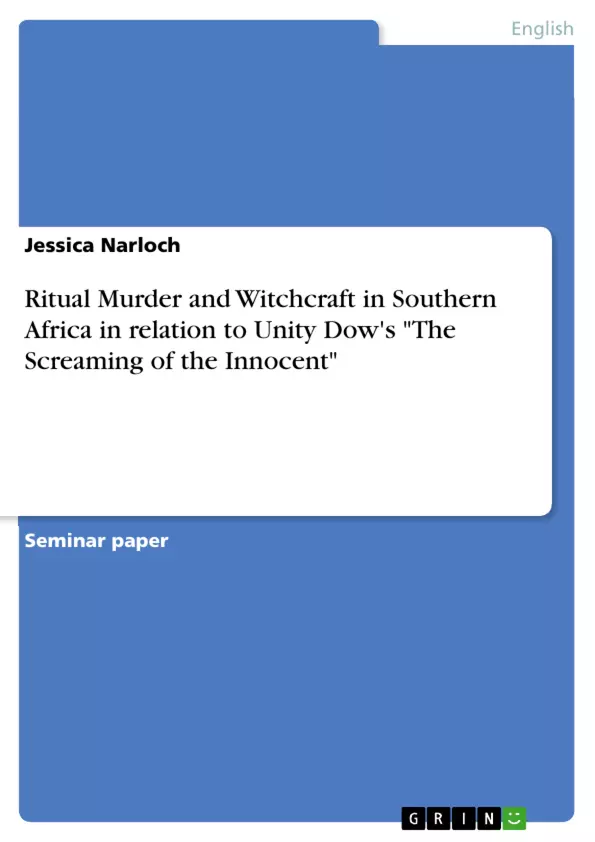In 2002, Unity Dow’s book The Screaming of the Innocent was published. It deals with the topic of ritual murder in Botswana and gives detailed descriptions of the South African belief in witchcraft, traditional healing and ritual murder. Since the book is not based on a true story it is interesting to find out whether the themes Dow writes about are fictitious as well or if they can be related to Botswana’s every-day life. In an interview Unity Dow claims that ritual murder actually still happens in Southern Africa.
This essay will have a closer look on some relevant passages of the book The Screaming of the Innocent and will relate them to the religion, the witchcraft belief, the belief in witchdoctors and the topic of ritual murder in Botswana. A comparison will show
whether there are parallels between the fictitious story of the book and the real life in this specific area of Southern Africa.
Inhaltsverzeichnis (Table of Contents)
- Introduction
- Unity Dow
- General Information
- Her Profession as a Judge and Human Rights Activist
- Her Profession as a Writer
- Unity Dow's The Screaming of the Innocent
- Summary
- Beliefs and Traditions - Witchdoctors
- Chapter 9 - The Witchdoctor
- Chapter 19 The Witch in the Yard
- Chapter 20 - The Healing of Ramarago
- Ritual Murder
- Chapter 1 - The Victim and the Perpetrators
- Chapter 24 - Description of a Murder
- South Africa - Botswana
- Common Facts
- Religion
- Witchcraft Beliefs and Witchdoctors
- Muti Murders
- Recent Cases of Ritual Murder in South Africa
- Comparison
- Conclusion
- Bibliography
- Appendix
- Articles from AllAfrica.com
- Interview with Unity Dow
Zielsetzung und Themenschwerpunkte (Objectives and Key Themes)
This essay aims to analyze Unity Dow's novel, "The Screaming of the Innocent," in relation to the themes of ritual murder and witchcraft beliefs in Southern Africa. It explores the connection between the fictional story and the realities of Botswana's society. Through a comparison of the book's narrative with real-life events, the essay examines the prevalence of witchcraft beliefs, the role of witchdoctors, and the occurrence of ritual murder in the region.
- Ritual Murder in Botswana
- Witchcraft Beliefs and Traditional Healing Practices
- The Role of Witchdoctors
- Cultural and Societal Influences on Crime
- The Intersection of Fiction and Reality
Zusammenfassung der Kapitel (Chapter Summaries)
The essay begins by providing a brief overview of Unity Dow's background and career, highlighting her role as a judge, human rights activist, and writer. It then delves into the plot of "The Screaming of the Innocent," focusing on the murder of a young girl and the subsequent investigation. The essay explores the various characters and their interactions, emphasizing the themes of corruption, power dynamics, and the struggle for justice.
The essay then analyzes key chapters that depict witchcraft beliefs and the role of witchdoctors in the narrative. It examines the scene where Motlatsi, the mother of the victim, seeks help from a witchdoctor for her "female condition," showcasing the complexities of traditional beliefs and their impact on individual lives.
Finally, the essay examines chapters dealing with ritual murder, providing insights into the motivations and methods of perpetrators. The essay explores the social and cultural context surrounding these crimes, drawing connections between the fictional narrative and real-life cases of ritual murder in South Africa and Botswana.
Schlüsselwörter (Keywords)
The essay focuses on the intersection of literature and socio-legal issues, employing keywords such as ritual murder, witchcraft beliefs, traditional healing, witchdoctors, Botswana, South Africa, human rights, and cultural influences. It explores the themes of justice, corruption, power dynamics, and the complexities of traditional beliefs in a contemporary context.
- Quote paper
- Jessica Narloch (Author), 2007, Ritual Murder and Witchcraft in Southern Africa in relation to Unity Dow's "The Screaming of the Innocent", Munich, GRIN Verlag, https://www.grin.com/document/186365



